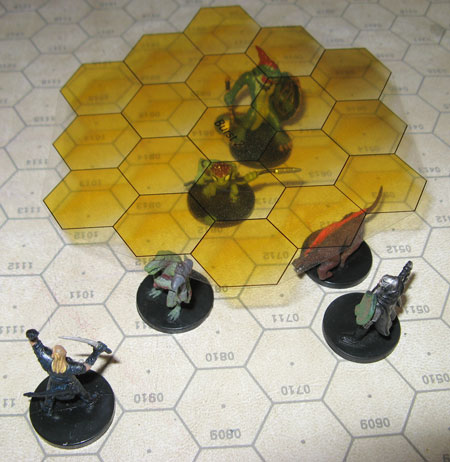I'm a fan of hexes and we've been using them in a variety of games, including both 3.5 and 4E D&D. Don't worry about crossing the grid lines and you can draw anything you want. I sometimes use a ruler and just draw the walls to whatever size I need. Square grids have exactly the same problem when dealing with round rooms or building dimensions that are not an even multiple of 5 feet.
When it comes to spell areas, it is true that the number of hexes affected by a burst spell is fewer than the number of squares it would affect on a square grid. The number of enemies that can surround you is likewise smaller. None of my players has found this to be a problem, but then again, they have only played 4E on a hex grid, so they don't know any better.

I personally prefer the more rounded shape (hexagonal really) of the spells, because firecubes just seem wrong. Blast spells translate into cones, and do cover the same number of hexes as they would on a square grid. In order to help figure out what area spells will hit, I made a bunch of hex grid templates. There's a link to the post in my sig, but here's one of them.
.
In the PDF I spent a bit of time talking about why I made the shapes the way I did, and the issues of the number of hexes in burst spells.
I don't have a problem with larger creatures. I just put them on the grid and see which hexes their bases cover. If a given hex is more than half covered, then the creature is occupying that hex. I don't need to change the round base into some other shape to make it work. When it comes to determining flanking against large creatures, we just eyeball it. Are those hexes on opposite sides of the creature in a straight line? Then yeah, it's a flank.
I'm sure part of our group's preference is that it's what we are used to, and we have a nice hex mat from Chessex that covers the dining room table. It's not one of the two-sided ones, so I'd need a new mat to go with squares. I honestly don't see any real benefit to squares however. The math thing would bug me a bit, because you can't just eyeball distances anymore. Diagonals are shorter (in squares) than they are in actual distance (with a ruler). If I have a square grid battle mat for something, I may go ahead and use it, squares and all, if I feel it's conveying the right feel for that area. If it's just a bunch of rocks and bushes, I'll draw in the relevant terrain on the hex mat and use paper props.
All grid systems are an artificial constraint on how things move in relation to each other. Either system works, but both have flaws. Hexes are nice for determining flanking, counting movement without worrying about the square root of 2, and making spells more round and less boxy. Your character is not closer to someone who is 8 inches away from him diagonally than he is to someone who is 8 inches away from him in a straight line (measuring with a ruler). Sure, he may walk with a bit of a side to side waddle, but it's better than playing hopscotch by jumping into squares and throwing firecubes.




